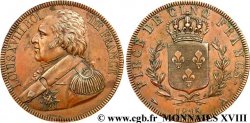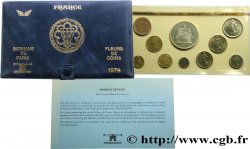- Accueil
- >
- >
fme_883643 - LOUIS XVIII Médaille parlementaire
Not available.
Item sold on our e-shop (2024)
Price : 180.00 €
Item sold on our e-shop (2024)
Price : 180.00 €
Type : Médaille parlementaire
Date: 1820
Metal : silver
Diameter : 40,5 mm
Orientation dies : 12 h.
Engraver ANDRIEU Jean-Bertrand (1761-1822) / DE PUYMAURIN Jean-Pierre (1757-1841)
Weight : 39,87 g.
Edge : lisse
Puncheon : sans poinçon
Coments on the condition:
Médaille nettoyée, présentant quelques coups et rayures, notamment sur les bords de la tranche
Obverse
Obverse legend : LOUIS XVIII ROI DE - FRANCE ET DE NAVARRE.
Obverse description : Buste à droite de Louis XVIII; signé : ANDRIEU F. et DE PUYMAURIN D..
Reverse
Reverse legend : VIVE LE ROI // CHAMBRE / DES DÉPUTÉS // SESSION DE / 1820.
Reverse description : Légende en sept lignes sous une couronne, dans une couronne de chêne.
Commentary
La médaille, conservée dans une boîte marron à feutrine verte, est non décernée.
La Chambre des députés des départements (selon le titre exact de cette assemblée dans la charte de 1814), ou plus usuellement Chambre des députés, était une assemblée législative française instituée par la charte de 1814 et élue au suffrage censitaire.
Elle est constituée le 4 juin 1814 par les membres du Corps législatif de l’Empire, et compte alors 237 membres. Le 20 mars 1815, au début des Cent-Jours, elle est dissoute et remplacée en juin par une Chambre des représentants.
Après le retour de Louis XVIII, les élections des 14 et 22 août donnent aux ultra-royalistes ou ultras une majorité de 350 sièges sur 400. Le roi parle de « Chambre introuvable » ; gêné par son radicalisme réactionnaire, il la dissout le 5 septembre 1816, et le 25 octobre, les élections sont favorables aux « constitutionnels », c’est-à-dire aux modérés.
Les députés sont d’abord élus pour cinq ans et la Chambre renouvelée par cinquièmes. En application de la loi du 9 juin 1824, leur mandat est de sept ans et le renouvellement est intégral. Les élections, en 1827 et 1830, seront cependant provoquées par des dissolutions..
The medal, kept in a brown box with green felt, is not awarded.
The Chamber of Deputies of the Departments (according to the exact title of this assembly in the charter of 1814), or more usually Chamber of Deputies, was a French legislative assembly established by the charter of 1814 and elected by census suffrage.
It was formed on June 4, 1814 by members of the Legislative Body of the Empire, and then had 237 members.. On March 20, 1815, at the beginning of the Hundred Days, it was dissolved and replaced in June by a House of Representatives.
After the return of Louis XVIII, the elections of August 14 and 22 gave the ultra-royalists or ultras a majority of 350 seats out of 400.. The king spoke of an \\\"unfindable Chamber\\\"; embarrassed by its reactionary radicalism, he dissolved it on September 5, 1816, and on October 25, the elections were favorable to the \\\"constitutionalists,\\\" that is to say, the moderates..
The deputies are first elected for five years and the Chamber renewed by fifths. In application of the law of June 9, 1824, their mandate is seven years and renewal is complete.. The elections in 1827 and 1830, however, were caused by dissolutions.
La Chambre des députés des départements (selon le titre exact de cette assemblée dans la charte de 1814), ou plus usuellement Chambre des députés, était une assemblée législative française instituée par la charte de 1814 et élue au suffrage censitaire.
Elle est constituée le 4 juin 1814 par les membres du Corps législatif de l’Empire, et compte alors 237 membres. Le 20 mars 1815, au début des Cent-Jours, elle est dissoute et remplacée en juin par une Chambre des représentants.
Après le retour de Louis XVIII, les élections des 14 et 22 août donnent aux ultra-royalistes ou ultras une majorité de 350 sièges sur 400. Le roi parle de « Chambre introuvable » ; gêné par son radicalisme réactionnaire, il la dissout le 5 septembre 1816, et le 25 octobre, les élections sont favorables aux « constitutionnels », c’est-à-dire aux modérés.
Les députés sont d’abord élus pour cinq ans et la Chambre renouvelée par cinquièmes. En application de la loi du 9 juin 1824, leur mandat est de sept ans et le renouvellement est intégral. Les élections, en 1827 et 1830, seront cependant provoquées par des dissolutions..
The medal, kept in a brown box with green felt, is not awarded.
The Chamber of Deputies of the Departments (according to the exact title of this assembly in the charter of 1814), or more usually Chamber of Deputies, was a French legislative assembly established by the charter of 1814 and elected by census suffrage.
It was formed on June 4, 1814 by members of the Legislative Body of the Empire, and then had 237 members.. On March 20, 1815, at the beginning of the Hundred Days, it was dissolved and replaced in June by a House of Representatives.
After the return of Louis XVIII, the elections of August 14 and 22 gave the ultra-royalists or ultras a majority of 350 seats out of 400.. The king spoke of an \\\"unfindable Chamber\\\"; embarrassed by its reactionary radicalism, he dissolved it on September 5, 1816, and on October 25, the elections were favorable to the \\\"constitutionalists,\\\" that is to say, the moderates..
The deputies are first elected for five years and the Chamber renewed by fifths. In application of the law of June 9, 1824, their mandate is seven years and renewal is complete.. The elections in 1827 and 1830, however, were caused by dissolutions.








 Report a mistake
Report a mistake Print the page
Print the page Share my selection
Share my selection Ask a question
Ask a question Consign / sell
Consign / sell
 Full data
Full data















